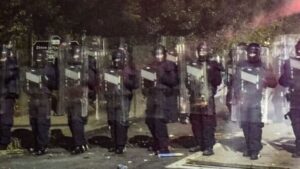In order to keep a strike group presence in the area, USS Theodore Roosevelt Carrier Strike Group was to be replaced by the aircraft carrier Lincoln and its strike group, per an order from Defense Secretary Lloyd Austin.
Before it is scheduled to return to the US, the Roosevelt will stay in the Middle East for a brief while, providing the US with two Nimitz-class nuclear-powered aircraft carriers.
The Lincoln, fitted with F-35C and F/A-18 Block III fighters, entered the area of responsibility (AOR) on Wednesday, according to the United States Central Command (CENTCOM).
Alongside a video uploaded on X, CENTCOM stated that it is accompanied by Carrier Air Wing (CVW) 9 and Destroyer Squadron (DESRON) 21.
The action coincides with an escalation of US military presence in the area in response to threats from Iran and its allies to exact revenge on Israel for the killings of senior Hamas and Hezbollah figures in attacks in Tehran and Beirut.
During a tense moment in the region, the Pentagon claims it is ready for a wide range of scenarios. “We at the [Pentagon] are a planning organization, but I understand the focus on this moment in time,” Maj. Gen. Pat Ryder, the press secretary, said to reporters on Tuesday. We are going to be prepared for a wide range of potential contingencies in addition to being ready for the here and now. You need both capability and capacity to accomplish that. Therefore, that is precisely what we have done and what we would be ready to do moving forward.
Additionally, Austin has directed the nuclear-powered USS Georgia to deploy to the CENTCOM AOR while it has been in the Mediterranean Sea. The Pentagon claims it is still in transit.
The US military has moved destroyers from the Gulf of Oman to the Red Sea as one of the other actions to strengthen force posture in the Middle East.
In response to the latest threats, more destroyers, fighter jets, and cruisers equipped with ballistic missile defense have been sent to Europe and the Middle East.
Unlike its retaliation against Israel in April following a deadly strike on diplomatic facilities in Syria, Tehran has not provided many clues about the nature or timing of its planned counterattack. Furthermore, it is unclear if the so-called “axis of resistance” will respond separately or coordinate their actions.
Hezbollah in Lebanon has threatened to attack Israel’s central region in retaliation for the killing of Fuad Shukr, the organization’s top military commander. So far, the group has not done so.
Iran declared it would take revenge on Israel for the murder of Ismail Haniyeh, a prominent Hamas politician, who was in Tehran for the inauguration of the country’s new president. They also have not responded yet.
In a separate conversation, the top US military general discussed the current tensions along the Israeli-Lebanese border with his counterpart in Lebanon on Wednesday.
Joint Staff Spokesman Capt. Jereal Dorsey stated that Joint Chiefs of Staff Chairman Gen. CQ Brown stressed the necessity of preventing additional escalation in the area in cooperation with allies and partners. The Middle East region is committed to long-term, sustainable security and stability, and the US and Lebanon share this commitment, according to Dorsey.





